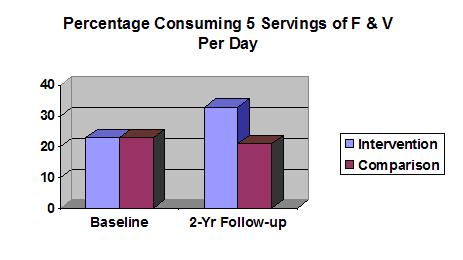Program Synopsis
Designed to increase fruit and vegetable consumption, this community-based intervention includes activities to increase awareness (e.g., receiving printed materials), fruit and vegetable access (e.g., gardening, recipe tasting, serving more fruits and vegetables at church functions), and social and environmental support (e.g., provision of lay health advisors, grocer and vendor involvement, church-initiated activities). The study showed an increase in fruit and vegetable consumption.
Program Highlights
Program Materials
Preview or download materials
Program Scores
The Need
Cancer is the second leading cause of death in the United States, and dietary factors have been linked to 30% or more of cancers. African-Americans have disproportionately higher rates of cancer incidence and mortality relative to other ethnic-racial groups in the United States. National disease prevention guidelines advise people to consume five servings of fruits and vegetables each day. Yet, less than one-third of American adults meet that target. Because a high percentage of African Americans attend and revere church, this institution may be an ideal venue for delivering information to increase fruit and vegetable consumption.
The Program
The program is a multi-component intervention with an ecological framework, targeting activities at the individual, social network, and community levels. Activities are targeted to affect three types of factors - predisposing, enabling, and reinforcing - to increase fruit and vegetable consumption. Activities to increase awareness include receiving tailored bulletins and printed materials. Activities to increase fruit and vegetable access include gardening, education sessions, cookbook and recipe tasting, and serving more fruits and vegetables at the church functions. Activities to increase social and environmental support include the provision of lay health advisors and pastoral supports, the creation of community coalitions, grocer and vendor involvement, and church-initiated activities.
Time Required
Time required varies by site. Churches must schedule time to create nutrition action groups, identify lay health advisors, engage such community members as grocers and farmers, establish county coalitions, grow gardens, and conduct outreach through mailings and sermons. The study intervention lasted approximately 20 months. Interventions were diverse and included establishing leadership and capacity within each church for program delivery.
Intended Audience
Participants were men and women in rural North Carolina who attended their church at least once a month. Participants included African Americans (98%), multiracial groups (1%), other (1%); and 73% of the sample was female aged 18 and older.
Suitable Settings
This intervention is suitable for implementation in church settings.
Required Resources
Required resources include the intervention booklet, "5 a day for Better Health! Black Churches for Better Health." This booklet contains 12 monthly packets, each replete with nutrition fact sheets, bulletin board ideas, suggested activities, inserts for the church bulletin, and sample month calendars. Also included is the manual, "Up Where We Belong - A Guide to 5-a Day for Better Health", and the associated guidebook for leaders. Church pastors are recommended to select six members for the Nutrition Action Team, responsible for program delivery. In addition, the use of lay health advisors is also recommended. Two cookbooks, "Cookin' with Pizzazz" and "A Taste of 5 a Day", are recommended as examples of cookbooks created during the study. Local newspapers and radio stations publicized the project and the importance of nutrition in cancer prevention.
About the Study
50 Black churches within 10 rural counties in eastern North Carolina were randomly assigned, by county, to receive either the intervention or delayed intervention. All active members (those attending at least once per month) were included in the study (N = 3,737). In the early implementation phase, intervention churches held kickoffs, and "5-a-Day Sundays". Each pastor selected a Nutrition Action Team, responsible for carrying out activities that addressed three types of factors: predisposing, enabling, and reinforcing.
- Predisposing activities were designed to raise awareness of the diet-cancer relationship, the 5-a-Day program, and to give individualized feedback to motivate participants to start changing behavior. Activities targeting primarily predisposing factors included tailored bulletins and printed materials.
- Enabling activities were designed to increase access to fruit and vegetables, to provide education and skills in preparing them, and to help overcome barriers to consumption. These activities included gardening, educational sessions, cookbook and recipe tasting, and serving fruits and vegetables at church functions.
- Reinforcing activities were designed to increase social and environmental support for eating more fruits and vegetables. These activities included community coalitions, the use of lay health advisors, pastor support, grocer-vendor involvement, and church-initiated activities.
Results indicated:
- At 2-year follow-up, intervention participants consumed 0.85 more servings of fruits and vegetables per day than participants in the control group.

- At baseline, approximately 23% of both groups were consuming 5 servings of fruits and vegetables per day. At 2-year follow-up, 33% of participants in the intervention group met this guideline, compared to 21% of participants in the control group.



